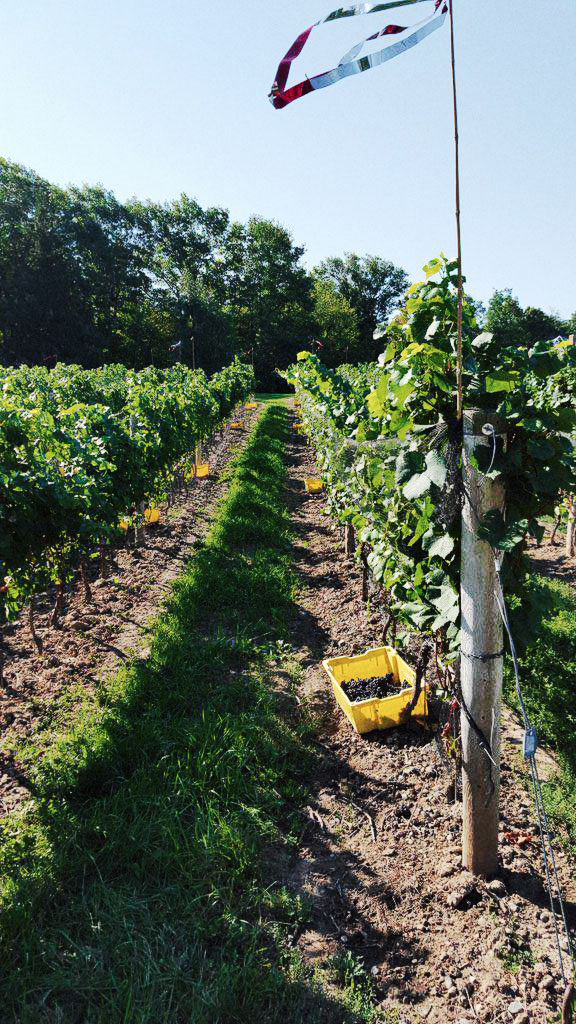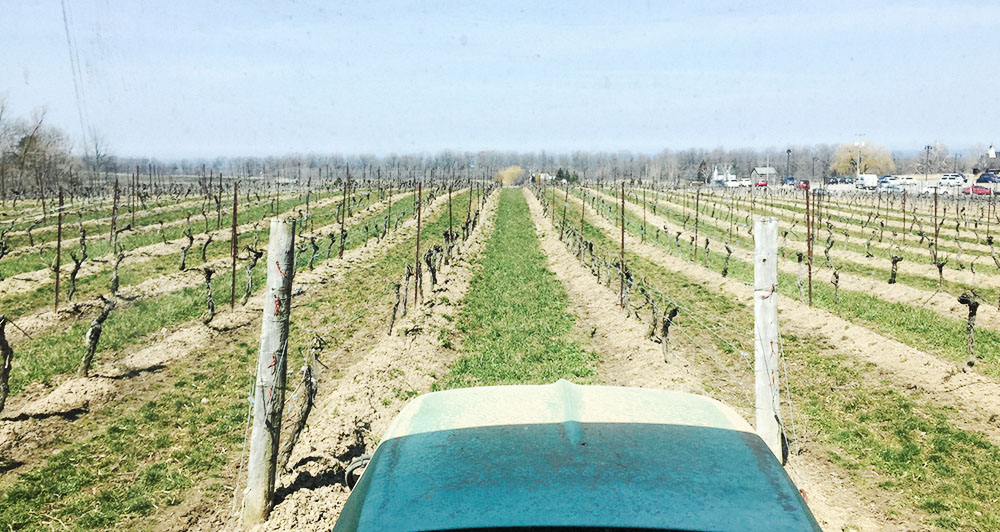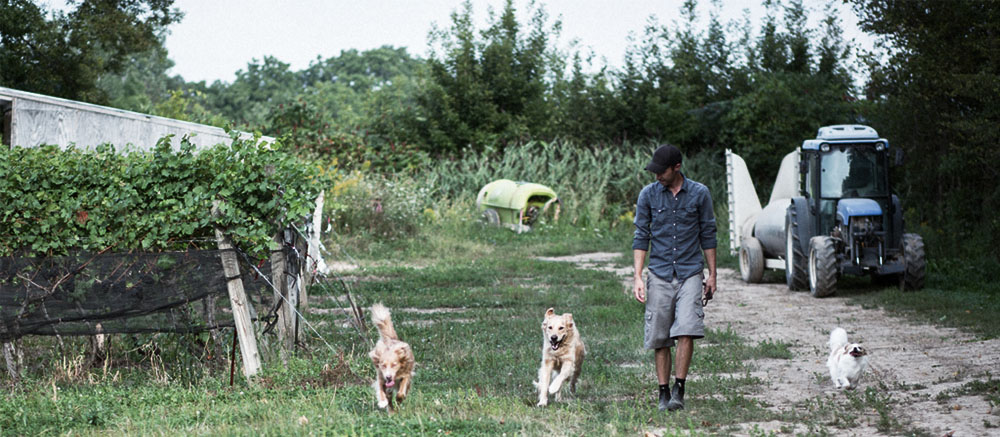Thou shalt not covet thy neighbour’s vineyard. Repeat after me. Thou shalt not covet thy neighbour’s vineyard.
It’s OK to look. It’s perfectly cool to gaze longingly over the fence at all that limestone-enriched dirt and those perfectly manicured rows of grapevines undulating gently in the summer breeze, but no coveting. That’s just wrong.
Niagara wine country is one big appellation spread across 13,600 acres and connected by sub-appellations and then broken down into hundreds of vineyards and individual blocks within the vineyard. Not all sub-appellations, vineyards and blocks are created equal and the grass, or in this case, the vines, always seem just a little a greener on the other side. Unless, of course, you are getting your fruit (or growing it yourself) from one of dozens of the region’s most admired vineyards.
They have familiar names, are planted in the right location and are tended to by the right people. The wines that are bottled each and every vintage are the best of what Niagara can do. And the vineyard name is displayed proudly on the label.
So, the question we asked was this: What are the Top Four vineyards in Niagara?
“Good luck with that,” Vineland Estate winemaker Brian Schmidt quickly replied after an email was sent out by this Quench scribe to nearly 40 winemakers, wine writers and industry stalwarts asking that very question.
“This sure is a tough question because not only does the site matter but also how it’s nurtured,” chimed in Château des Charmes’ director of marketing Michèle Bosc.
“Oh my, I think Brian is correct in that this is going to be a challenging one that will break a few hearts,” said Toronto-based wine writer Mike Di Caro. “But I think that it’s a good (question) and an important discussion to talk about top vineyard sites as the Niagara wine scene evolves and develops.”
If place matters, if “terroir” is a thing, then it only stands to reason that exactly where you plant your grapes and what you do with them is everything.
It is like that with the Cave Spring Vineyard on the Beamsville Bench. In 1978, the Pennachetti family was among the first to plant Riesling and Chardonnay vines in the Niagara Peninsula. The vineyard draws its personality from the escarpment’s limestone, shale and sandstone that’s rich in minerals, yet limited in organic matter, creating the perfect balance of nutrients for growing grapes displaying character and sophistication.
CSV topped our informal Quench poll naming Niagara’s Top Four vineyards by a significant margin.
Said Thirty Bench winemaker Emma Garner: “CSV is an epic Riesling vineyard which helps to define our region and helps the world see what amazing Riesling we can make here.”
The CSV Riesling from Jordan’s Cave Spring Cellars is on regular rotation at North America’s most influential wine magazine, Wine Spectator, and garners high scores vintage to vintage. It is, perhaps, the most famous single wine — that isn’t an Icewine — getting exposure beyond Canada’s borders.
If the grass is always greener on the other side, you won’t catch Schmidt looking over the fence. The Vineland Estate winemaker stands on hallowed ground, a beauty of a vineyard steeped in history and soaked in one of the purest expressions of Riesling in all of Canada. It was the second-most important vineyard mentioned in the Quench poll.
The St Urban Vineyard, tucked away in the heart of the Twenty Mile Bench, showcases the Weis 21 Riseling clone, brought to Canada by the winery’s founder, Hermann Weis. The first vines were planted in 1979 followed by more plantings in 1980 and 1981 to bring the total to 42 acres of Riesling with just a sprinkling of Chardonnay musqué. Hailing from the Mosel in Germany, Weis was an experienced grape-grower who knew exactly what would grow successfully in the Niagara Region.
The original St Urban blocks are still intact with about 60 per cent of the original vines (the rest replanted as needed) spread across seven distinct sections, or “fields,” of the vineyard. Schmidt bottles the St Urban and Reserve Rieslings most vintages and always has special vineyard- and block-specific bottlings for the winery’s dedicated wine club members. These always provide an exploration of the subtle differences in terroir shown by individual blocks influenced by sunlight, geography and age of vines. The commonality in all the St Urban wines is a “tight, restrained and minerally-focused” profile with “racy acidity.”
What makes a great single vineyard, says Schmidt, “is how it responds to the challenges and finding the consistency year after year. You need a common thread each vintage.”
Schmidt has experimented endlessly with what works best in this fabled vineyard. He’s lowered and increased yields, compensated for hot, dry seasons and wet, cool ones. But after all the tweaking, he finds the magic potion at St Urban is really doing nothing at all.
“You have to have the confidence to let the vineyard moderate itself,” he says. The vineyard is self-sufficient with a mind all of its own. With its limestone-clay composition, the old vines have deep roots and will always find the water level. “The ability of a vineyard to hold and retain that water is crucial,” he says.
Schmidt says that with St Urban “it was a learning curve, but now we just get the [bad word here] out of the way and let the vineyard do its thing.”


It’s like that with the world’s top vineyards and Niagara winemakers are just starting to realize the potential of these singular entities that shine brighter than the sub-appellations where they grow and the region as a whole.
Niagara is blessed with a rich history (albeit short, in the scheme of things) of single vineyards that show consistency and quality vintage to vintage.
Chateau des Charmes’ Paul Bosc Vineyard is the jewel of St Davids, planted in 1983 and 1984 over 60 acres just across the street from the winery on York Road with the first vintage in 1988.
Winery founder Paul Bosc planted the vineyard, consisting of Smithville clay loam and small pockets of Haldimand clay loam, and the family patriarch still presides over the immaculately tended vines to this day. Grown in the vineyard are Chardonnay, Cabernet Franc, Cabernet Sauvignon, Merlot, Pinot Noir and Riesling. The Chardonnay was the first Canadian table wine to win a gold medal at VINEXPO.
The enviable vineyard was mentioned by several respondents to the Quench poll as a top single vineyard in Niagara along with, but not confined to the following:
Les Clos Jordanne Vineyard, launched in 2006, was a collaboration between Vincor Canada and France’s Boisset family, and is now owned by Constellation Brands. Using traditional Burgundian methods, the top wines from the Les Clos Vineyard, both the Chardonnay and Pinot Noir, are some of the finest made in Niagara. Sadly, as of the 2012 vintage, Constellation announced it will not be making any more Le Clos wines due to back-to-back short crops.
Rosomel Vineyard, No. Four in our poll, is located six kilometres to the east of the Hidden Bench Winery, at the base of the Niagara Escarpment on the Beamsville Bench. It was purchased by Hidden Bench owner Harald Thiel in the fall of 2004. Consisting of 26 acres, Rosomel was planted in 1976 by Roman Prydatkewycz, now the viticulturist at Vineland Estate, and has produced award-winning wines consistently over the years. This site produces the fruit for Hidden Bench’s Nuit Blanche and La Brunante as well as the estate Vieille Vignes Chardonnay and the legendary Roman’s Block Riesling.
Moira Vineyard on the Beamsville Bench, purchased in 1995, is the source of Malivoire’s original wines, notably the single-vineyard Chardonnay and Pinot Noir. So taken was owner Martin Malivoire by its breathtaking escarpment scenery, he also made it his home. With excellent drainage and a low water table, the Moira Vineyard is distinguished by vines whose deep roots ensure robust health and vigorous fruit acidity.
“These wines have always had harmony of aromatics, texture and length while aging infinitely … the 1998 [first vintage] is still showing beautifully,” commented Southbrook winemaker Ann Sperling.
The list could go on, of course: Thirty Bench and its three Riesling blocks (Wood Post, Triangle and Steel Post), Lenko Vineyard’s historic plantings on the Beamsville Bench, the ubiquitous Wismer Vineyard (notably the Foxcroft, Wismer Parke and Wingfield blocks), plus Hidden Bench’s Felseck Vineyard and Flat Rock’s Nadja’s Vineyard.

And then there’s the Lowrey Vineyard, coming in at number three in the poll, and perhaps the toughest ticket in Niagara to purchase the coveted fruit.
Located in the St Davids Bench sub-appellation, the fifth-generation Lowrey property is a 35-acre vineyard that is the source for some of Ontario’s most prestigious wines made by accomplished winemakers.
The Lowrey family has farmed the area for five generations — everything from cherries, plums and pears to labrusca grapes.
It was only with the current generations, Howard and Wilma Lowrey and their son Wes, that vinifera was planted in the lower part of property they purchased from Howard’s dad in the early ‘80s. It was Karl Kaiser, co-founder of Inniskillin, who convinced the farming family to ditch the labrusca and turn to the emerging trend of vinifera (noble) varieties.
The first grapes planted were the original “Five Rows” of Pinot Noir Clone 115, made famous in 1993 by the Alliance project, the first joint venture between Canada and France with Inniskillin and Jaffelin of Cote D’Or, Burgundy. Winemakers Kaiser and Bernard Repolt collaborated from 1993 to 2007 on these VQA wines, which caused a stir back in the day for their quality, closely aligned to Burgundian Pinot and Chardonnay, and had a cult-like following.
Inniskillin purchased the Lowrey fruit until 1999, then Niagara’s Creekside Estate Winery came knocking and took everything the Lowreys could grow, even convincing the family to plant Pinot Gris, Sauvignon Blanc and Syrah.
Creekside was going through some changes, and in 2007, decided to abandon Pinot Noir, leaving the door open for Thomas Bachelder, who was just starting up his tri-country wine project. Ilya Senchuk, who was the winemaker at Foreign Affair but had embarked on a virtual wine project, Leaning Post (now a full-fledged winery in Winona), and Richie Roberts, the winemaker at Fielding Estate, and, more recently, the new Adamo Estate Winery in the Hockley Valley also got a piece.
By 2007, Wes Lowrey, who studied oenology and viticulture at Brock University, was making his limited 800-case portfolio of wines, including Pinot Noir, Sauvignon Blanc, Pinot Gris, Syrah and Riesling under the Five Rows Craft Wine label. The wines, having reached cult status, sell out quickly every vintage.
It is one of the most unique opportunities in Niagara to see how Lowrey and other winemakers, who each get a small portion of the original Five Rows of Pinot Noir at Lowrey Vineyard, treat the fruit.
“History has shown there are differences not only in the appellation but also in each vineyard, even over our 35 acres,” Wes Lowrey tells me over lunch. “How could you not think there’s something to be explored there? Old family farms, old blocks will show such varietal characteristics that we have to explore them.”
The fruit from the Lowrey farm is some of the most sought after in Niagara with constant inquiries from winemakers wanting whatever they can get.
“It tells me,” says Wes Lowrey, “that people are looking for single-vineyard wines in Niagara. It’s interesting that we have these little pockets where we can push forward terroir-driven wines. I just love seeing what Thomas [Bachelder] or Richie [Roberts] do with those grapes. It’s like a feather in your cap.”

except for St. David’s Bench, no mention of the balance of NOTL vineyards.